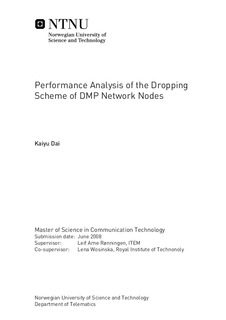| dc.contributor.advisor | Rønningen, Leif Arne | nb_NO |
| dc.contributor.advisor | Wosinska, Lena | nb_NO |
| dc.contributor.author | Dai, Kaiyu | nb_NO |
| dc.date.accessioned | 2014-12-19T14:12:22Z | |
| dc.date.available | 2014-12-19T14:12:22Z | |
| dc.date.created | 2010-09-03 | nb_NO |
| dc.date.issued | 2008 | nb_NO |
| dc.identifier | 347710 | nb_NO |
| dc.identifier | ntnudaim:4193 | nb_NO |
| dc.identifier.uri | http://hdl.handle.net/11250/261758 | |
| dc.description.abstract | The Distributed Multimedia Play (DMP) is new generation of multimedia communication systems which provides near-natural virtual collaborations for long- distance users. To approach near-natural perceptions, DMP produces huge amount of traffics and requires very restrict delay of the Multimedia Content packets. If the traffic of a network node of DMP overloads, this node has to drop some packets selectively. To ensure the graceful degradation of quality, a special dropping scheme is designed particularly for the DMP network nodes. This thesis analyzes the performance of the DMP nodes with the special dropping scheme. This thesis focuses on building analytic models to calculate the delay and loss rate of the traffics of the DMP nodes. Two simulators are developed to verify the analytic models. Several experiments are carried out on the two simulators to test the performance of the network nodes in different conditions. More specifically, the thesis work will be aiming at the following objectives: 1. To provide a concise and clear introduction to DMP and its special dropping scheme. 2. To describe the simulation models of the two simulators, explaining their functions and the input and output of them. 3. To build analytic models to calculate the delay and the loss rate of the packets passing through one DMP network node or passing through several network nodes of a DMP collaboration. 4. To provide some suggestion about how to improve the performance of the DMP networks. The main contributions of this Master s thesis are the two simulators and the analytic models. Three analytic models are proposed to calculate the delay and loss rate of one DMP network node. They are M/D/1 with infinite queue model, M/D/1 with dynamic queue model and M/B/1 with dynamic queue model. The calculation results of those models are consistent well with the simulation results in the experiments. The analytic models can also be applied to universal queuing systems in which dropping queue and normal queue converge. | nb_NO |
| dc.language | eng | nb_NO |
| dc.publisher | Institutt for telematikk | nb_NO |
| dc.subject | ntnudaim | no_NO |
| dc.subject | SIE7 kommunikasjonsteknologi | no_NO |
| dc.subject | Telematikk | no_NO |
| dc.title | Performance Analysis of the Dropping Scheme of DMP Network Nodes | nb_NO |
| dc.type | Master thesis | nb_NO |
| dc.source.pagenumber | 123 | nb_NO |
| dc.contributor.department | Norges teknisk-naturvitenskapelige universitet, Fakultet for informasjonsteknologi, matematikk og elektroteknikk, Institutt for telematikk | nb_NO |

